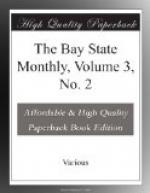“Isn’t the thought inspiring,” I remarked to my companions, “that we are on the highest land for which our fathers fought a century ago?”
“And is it not the theme the ultima thule of grandeur in an artist’s pilgrimage?” said Molly. “What a prospect! The plains of Canada, the forests of Maine, the mountains of New York, and I really believe the sea, if I mistake not that faint blue line in the far distance over the billowy land! What a grand spectacle a sunrise or a sunset would be, viewed from this height!”
[Illustration: Mount Moriah, in Gorham.]
The next morning we saw the sun start from its bed in the Orient, swathed in radiant clouds and vapors, and rise up behind the eastern range of hills; we had never seen anything so beautiful and striking before, and the scene is one which neither pen can describe nor pencil portray. Our memory will not fail to cherish it as the choicest revelation to be seen in a life time.
[Illustration: Echo lake.]
“Do you know it was just one hundred years ago this very year, 1784, Mount Washington received its name?” asked Fritz. “Well it was, and eight years later Captain Eleazar Rossbrook penetrated into the heart of the mountains and made a clearing where the Fabyan House now stands. His son-in-law, Abel Crawford, the patriarch of the mountains, settled the next season in the Notch, in the vicinity of Bemis station. Captain Rossbrook built the first house for the reception of visitors in 1803. Ethan Allen Crawford, son of Abel Crawford, took Captain Rossbrook’s house in 1817, and two years later opened the first footpath to the summit of this mountain, where he soon after built a stone cabin. There, I give all that information to you gratis.”
“Very kind of you, I am sure,” said Molly, “but who will vouch for its authenticity?” you used to be a terrible story-teller.”
“Clio does not lie; this is history.”
“You would have us believe the staid muse very modest,” said Molly. But I remember some one has said history is a great liar.”
“A libel, a positive libel! Shall we believe nothing?”




